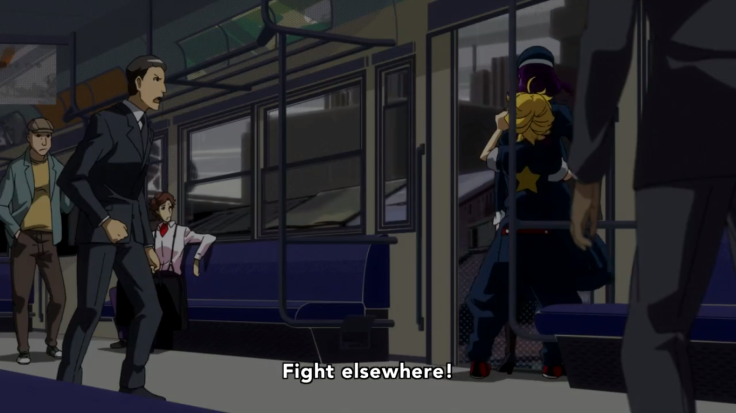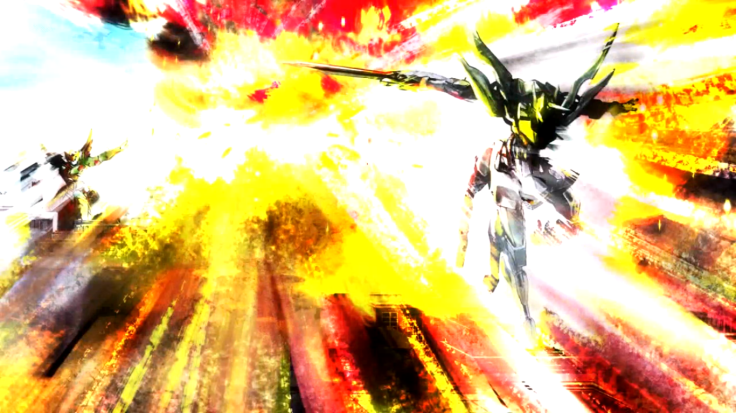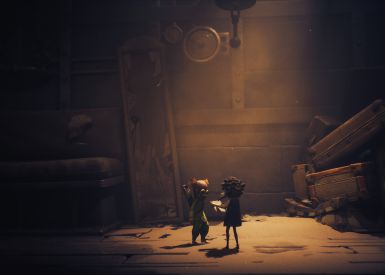The 2015 fall anime season holds a lot more of interest than the summer did : we’ve got second seasons of Noragami (which is a must-watch, by the way), Haikyuu, and Seraph of the End to watch, as well as Young Black Jack, One Punch Man, the new Lupin series that premiered in Italy, and today’s subject, the original sci-fi concept anime Concrete Revolutio . Fall anime season 2015 is shaping up nicely.
So, about Concrete Revolutio: it’s produced by Bones, the studio behind Wolf’s Rain, Darker Than Black, Ouran High School Host Club , and two adaptations of the Fullmetal Alchemist manga. In short, Bones Studio has a wide range of styles, knows what it’s doing and does it well. Director Seiji Mizushima directed Fullmetal Alchemist and Shaman King, among other shows, and writer Sho Aikawa was head writer on Fullmetal alchemist as well as an experienced tokusatsu-genre writer.
I believe that they have put everything they know how to do into Concrete Revolutio, all at once… and honestly, the result is an almost unwatchable passion project made with so much love, you want to try and watch it anyway. Here’s the salient features of Concrete Revolutio that jump out at me, based on the first two episodes of the show.

The art is really striking and glorious.
I loved the art in No Game No Life and Gankutsuou, shows that pushed the boundary in terms of how busy and bright the screen could be. The show has all different types of styles: you’ve got Floater, a ghost boy who looks straight outta Tezuka and could sit side-by-side with Astro Boy without anyone blinking an eye; Kikko, a magical girl who goes from frilly maid cafe outfit to luxurious Harajuku princess gear after a lavish transformation sequence in the best Sailor Moon style; and protagonist Jiro, who’s got that magical red scarf of cool that every broody and angst-ridden hero must have. And pink hair. Gotta love a broody shounen hero with pink hair.

The opening and closing themes are impossibly cool and striking, showing off all the different styles this show runs through as frantically as an ‘80s banker searching his rolodex. The bright flashy colors incongruously jammed next to the pastels along with the retro-futurist and Lichtenstein-dotted look of Concrete Revolutio are probably the best thing about it. Why? Because --
Plot? What plot?
There is a plot. I know this because there are scenes which transition to other things, with the same characters moving through them. Sometimes, the screen shows placards with a date on them. The date changes on these placards, indicating that we’re flashing back to the future and to a present and to a past. But as a viewer we’re given no handle on what’s the present, what’s the future and what’s the past. Where are we now? Don’t know. Why should we care? Don’t know. What are the stakes? Don’t know. Think fast, it’s a Kamen Rider!

It appears that superhumans and aliens are acknowledged beings, along with monsters and ghosts, and that normal people must simply live their lives alongside them. Jiro (Red Scarf) is part of a government bureau that protects and manages the superhumans, sometimes simply by registering them and forcing them to live in protected housing, though how humans can force superhumans to do jack-diddly is not explained. Jiro has left this government bureau, we learn through flashback, and we know this because in the future (the past? the present?) he’s wearing his red scarf, but in the past (the present? the future?) he’s not.
The plot is flashy and bewildering and really hard to track upon first watch, so I’ll explain the plot of the first episode in detail, to give you an idea of how much movement the plot goes through in that 20-minute episode timespan.
Check out this damn plot.
The first episode’s plot revolves around a scientist who may or may not be selling industrial secrets to an alien spy, which winds up spiraling into the story of Grosse Augen, a heroic superhuman. After the alien spy is forced to reveal and defend itself, Grosse Augen emerges and battles the alien spy in the gap between seconds, while Jiro ries a car that transforms into an iron mecha-horse and joins forces with Grosse Augen. They vanquish the alien spy, but when Grosse Augen extends a hand, Jiro cuts it and then shoots a tracking substance into the wound. Grosse Augen disappears, and the alien spy, now a tiny version of itself, is stowed in a matchbox.

It turns out Grosse Augen has possessed a human, and neither of them can separate from one another. The human discovered Augen on the verge of death and gave his life to him on the condition that Augen devote himself to championing humanity. Somehow, despite Augen’s body being “at its limit,” he can still return to his homeland thanks to the human’s melding with him. (I don’t know.) So Grosse Augen, after a conversation with Jiro, peaces out for his home planet, leaving only the charred remnant of his human host on the sidewalk.
And the scientist wasn’t selling industrial secrets, he was trying to purchase what he thought was a well-intentioned gift that would help him pinpoint locations in the stars. The alien spy didn’t want his homeworld’s base being uncovered and was trying to sell the scientist a device that would feed him junk data.
And it turns out that Grosse Augen’s human host didn’t die, he actually merged with the comatose alien spy and used its body to fight for Earth. Why did Grosse Augen have to leave Earth? Because he was dangerous. Why? I don’t know. How was Jiro able to unfuse Grosse Augen from his human host? I don’t know. But five years from that point, Jiro quits the Bureau and Augen’s former host helps him escape. I think.
This is a lot, and the second episode is just as packed.
In short: should you watch Concrete Revolutio?
How high a tolerance do you have for not understanding what the hell you’re looking at, so long as it’s pretty to look at? If your tolerance for total non-comprehension is high, or you love watching things five times in order to comprehend a plot that may or may not be worth the effort, then you should go ahead and watch it. If you would like a more standard viewing experience that progresses linearly and reasonably and isn’t so stuffed with references and zaniness that you can scarcely get a handle on character names let alone plotlines, then this may not be the show for you.

For my part, I do plan to continue watching this show, if only because I support Bones’ effort to create an original sci-fi story that’s not an adaptation of anything. Once I started parsing the plot, I did feel it had some promise. The zaniness gets grating (why does the magic girl have a talking daruma doll sidekick in her cleavage? why does the ghost child exist?), and the sheer visual barrage of styles and colors is overwhelming, but surely somewhere in this episodic Superhuman/Alien of the Week format, they’re framing Jiro’s departure from the Superhuman Bureau to be an actually interesting thing that involves meaningful emotional tension.
Frankly, I’m not even sure if I should keep watching, but I kind of can’t look away. My endorsement’s not exactly a ringing one, but I’d say at least give it a shot. You can watch Concrete Revolutio at daisuki.net here, with new episodes every Sunday.


















